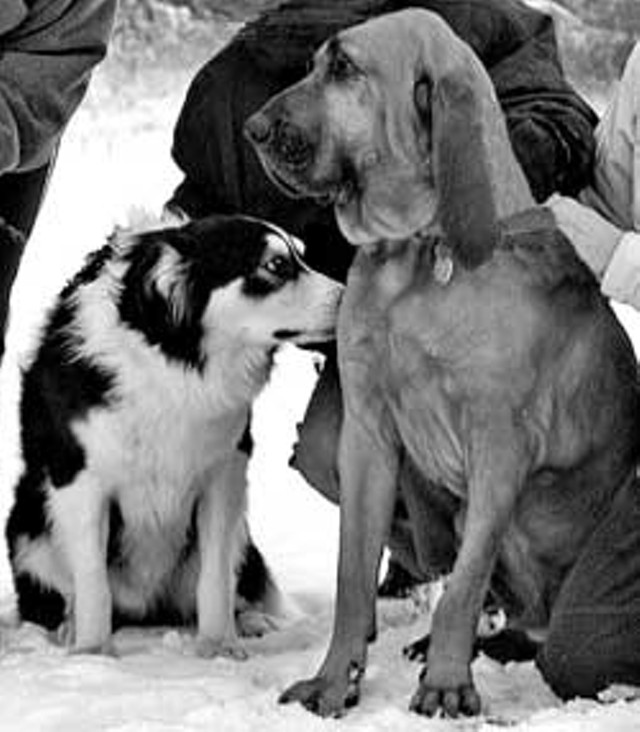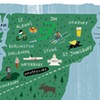Published March 24, 2010 at 9:36 a.m.
In early December 2009, an Australian shepherd rescue named Ben escaped from his Chester, Vt., yard. Spooked by the family’s horse, Ben pulled up the metal stake to which his long lead was attached and took off. Ben’s humans were devastated. They had brought him home just days before.
After a week of fruitless searching, the owners, who had just adopted the dog from a breed-specific rescue in northeastern Pennsylvania, connected with Lisa Robinson and her bloodhound, Thurber. They’d heard the Albany, Vt., woman and her 8-and-a-half-year-old dog had been involved in missing-pet searches and wondered if Thurber might be able to find Ben.
Robinson, a 63-year-old retiree, agreed to help. After driving three hours to southern Vermont, she put Thurber in his harness and gave him a sniff of a brush recently used on the Aussie. Then Thurber was off.
The dog followed Ben’s scent trail through the woods, onto a golf course and into a cluster of summer vacation homes. He wouldn’t quit, even when it was growing dark and Robinson had to finish for the day. Clearly, Thurber was on to something.
Robinson and Thurber drove down to Chester and back twice more before they found Ben. On the last day, Thurber tugged on his lead as Robinson and volunteers — including Sharon Gechter, who had fostered the pup in Pennsylvania — called out to the Aussie. Soon the bedraggled pup popped out of the woods, tired but happy to see friendly faces — especially Thurber’s.
Thurber was equally thrilled to have located his quarry, Robinson says. “It gave him closure,” she suggests. “Thurber’s whole attitude changed. His tail went up in the air, and he whined a little.”
Thurber is one of a small number of scent-trailing dogs that are used to find runaway pets. Nationwide, there are dozens of missing-pet “detectives,” but only a handful use dogs like Thurber. Robinson guesses her dog — one of three bloodhounds she owns — is the only Missing Animal Response dog in the state.
Because search-and-rescue dogs track only human scents (they are specifically trained not to pick up those of animals), they are not employed to find lost pets. Agencies that use K-9 teams will no more search for your missing poodle than they will locate your lost wallet.
But, says Robinson, scent-trailing dogs like Thurber are made for this kind of work. Bloodhounds’ noses contain 200 million specialized cells, compared with a human’s paltry six million. While all dogs have better sniffers than we do, bloodhounds are particularly adept at tracking scents because their nasal chambers, where scents are identified, are larger than those of other breeds. Plus, a bloodhound’s loose skin, floppy jowls and elephantine ears help push the scent toward his giant nose.
All these dogs need for pet tracking is an item containing the missing pet’s smell and a handler who will listen to what the dog is telling him or her. Robinson learned to “read” Thurber with the help of a three-day K-9 human-trailing course at the State Police Academy in Pittsford. It’s an essential skill in any canine tracking activity: “Always trust your dog,” Robinson says.
By following Thurber’s lead, Robinson can get a sense of where missing pets are headed or identify places they repeatedly return to, such as safe shelters or spots with food nearby. Understanding where the lost animals are traveling makes it easier to retrieve them. In one recent instance in Burlington, Thurber indicated that a lost Labrador retriever had been walking on the same path again and again. The owners of the missing dog were able to set a Havahart trap — a humane snare — on the trail based on where Thurber’s nose led them. The Lab was safely captured and returned home.
Since 2005, Thurber has been involved in seven pet searches with various degrees of success — about half the time, his tracking led to the lost animals. A 50 percent success rate may not seem so hot, but when you consider that finding lost animals with a MAR dog depends heavily on weather conditions and the time that elapses between the pet’s disappearance and the MAR dog getting on the trail, Thurber’s track record is actually pretty good. Cindy Kilgore, who organized the search for Ben, swears by his tracking skills. “We would have never found this dog alive without the nose of a bloodhound,” she says.
Robinson doesn’t charge for Thurber’s services, but she does ask that pet owners foot her gas bill. And she will happily take donations for the pair’s time and effort. The reward, she says, comes from finding a missing pet and seeing Thurber’s tail swirl with excitement at his success.
Info:
Lisa Robinson, [email protected] or 802-755-6331.
More By This Author
Speaking of Animals
-

Q&A: A Clinic Has Cared for Old North End Pets for Almost 20 Years
Jan 31, 2024 -

Video: The Old North End Veterinary Clinic Has Kept Costs Low to Help Pets in Burlington for Almost 20 Years
Jan 25, 2024 -

Q&A: Merrymac Farm Sanctuary in Charlotte Provides a Forever Home for Neglected Animals
Dec 6, 2023 -

Video: Neglected Animals Find a Home With Era MacDonald at Merrymac Farm Sanctuary in Charlotte
Nov 30, 2023 -

Response Teams Provide Shelter for Pets of Evacuated Vermonters
Jul 16, 2023 - More »
Comments
Comments are closed.
From 2014-2020, Seven Days allowed readers to comment on all stories posted on our website. While we've appreciated the suggestions and insights, right now Seven Days is prioritizing our core mission — producing high-quality, responsible local journalism — over moderating online debates between readers.
To criticize, correct or praise our reporting, please send us a letter to the editor or send us a tip. We’ll check it out and report the results.
Online comments may return when we have better tech tools for managing them. Thanks for reading.














































